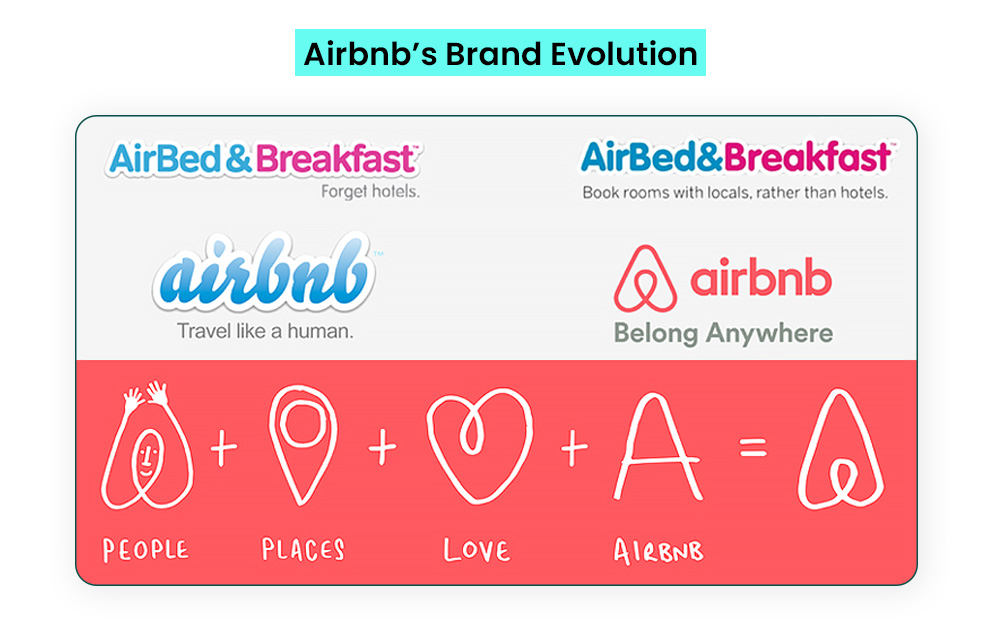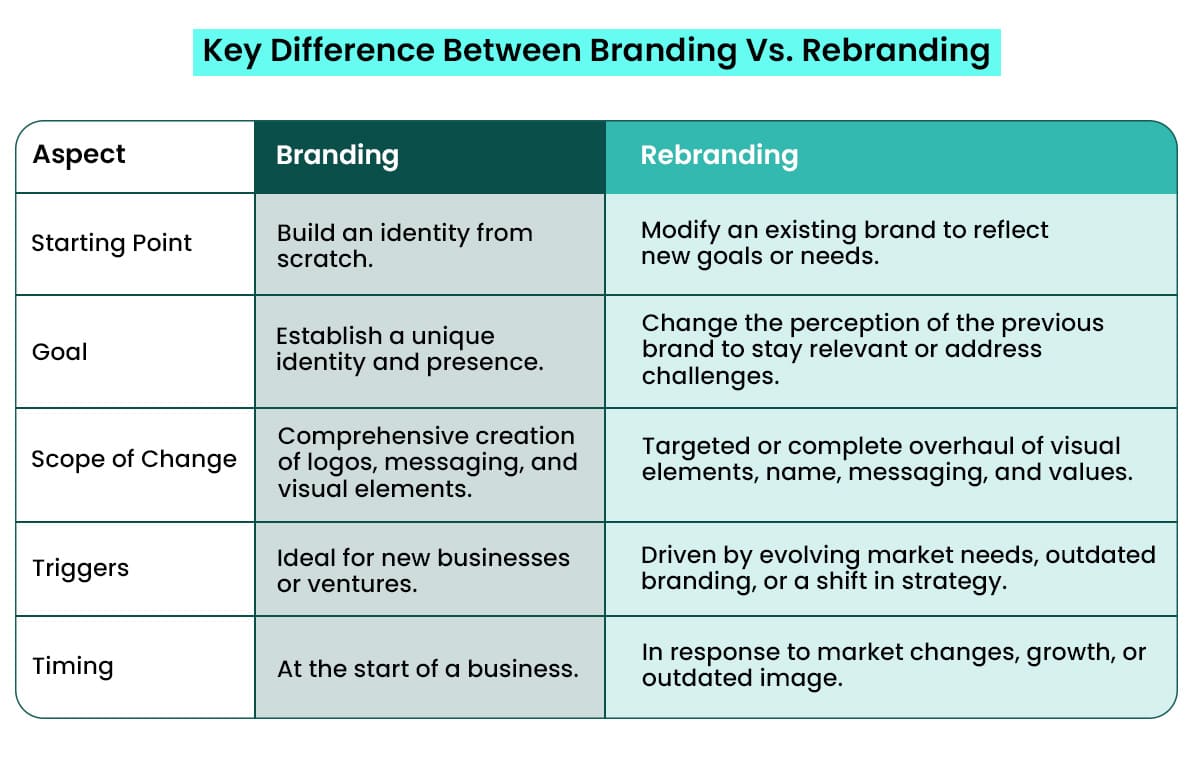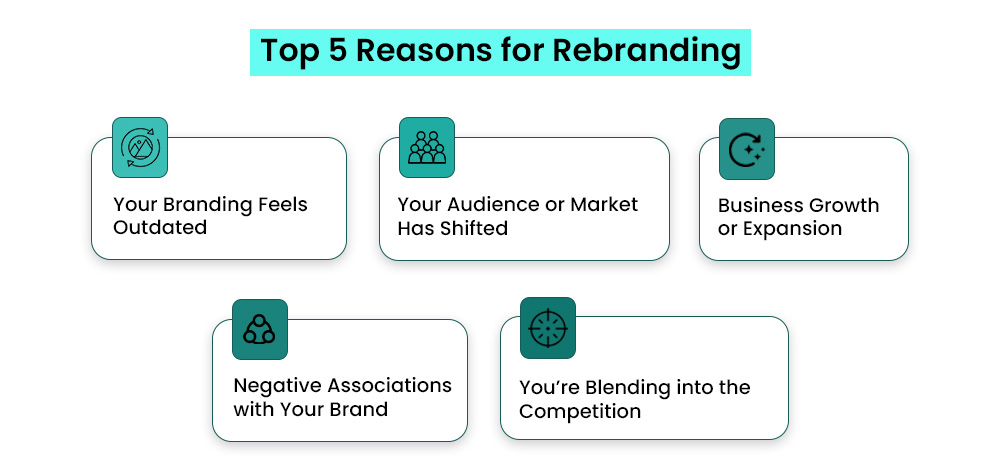Branding vs. Rebranding: What’s the Difference and Importance?
Every business, at some point, faces an important decision—should you create a new brand or update the one you already have? Branding vs. Rebranding isn’t just about design or marketing.
It’s a smart, strategic choice that can shape your future success. Knowing when to build from scratch and when to evolve can be the difference between growing strong or getting left behind.
Branding is the foundation of your business identity. It’s more than just a logo or a slogan, it’s how you show your values, your voice, and what you stand for. From the first impression to lasting trust, your brand helps people understand who you are.
But as time goes on, things change. Your audience, your goals, and the market itself may shift. When your current brand no longer fits, rebranding gives you the chance to realign and move forward with purpose. It’s not a sign of failure, but a way to stay fresh, relevant, and true to your growth.
In this blog, we’ll dive deep into branding vs. rebranding, unveil their differences, and help you decide which fits your business today. Whether you’re building from scratch or considering a refresh, this blog will give you the clarity you need to move forward with confidence.
Understanding Branding Vs. Rebranding
Branding vs. Rebranding isn’t just a design choice, it’s a strategic decision that shapes how your business is perceived, remembered, and trusted. Understanding the role of each can help you choose the right path based on where your brand stands today and where it’s headed tomorrow.
What Is Branding?
Branding is the process of creating a unique identity for your business. It’s how you shape perception, create recognition, and build trust with your audience. A strong brand is more than a logo, it’s a promise delivered consistently.
A well-thought-out branding strategy includes:
- Visual Identity: Your logo, colors, and design language that make you instantly recognizable.
- Tone & Messaging: The voice that speaks to your audience and communicates your values.
- Core Beliefs: The mission and values that drive your brand’s purpose.
- Positioning: What sets you apart in a crowded market?
Think of Apple’s simplicity, Nike’s motivation, or Coca-Cola’s emotional pull. These brands aren’t just known, they’re felt. That’s the power of intentional branding backed by a clear strategy.

– Also Read- What is Branding and Why Does It Matter?
What Is Rebranding?
Rebranding is the process of refreshing or completely transforming a company’s identity to better align with its goals, audience, or market trends. Unlike branding, which establishes an initial identity, rebranding efforts help businesses evolve and stay relevant.
There are two primary types of rebranding strategy:
- Brand Refresh: A visual and tonal update that keeps your core identity unchanged.
- Complete Rebrand: A full transformation with a new name, new look, and new message.
So, why do businesses invest in rebranding?
- Shifts in the market or audience
- A dated or inconsistent image
- Mergers or acquisitions
- A need to rebuild reputation
Great examples of a successful rebranding strategy include Airbnb’s sleek redesign and Old Spice’s bold repositioning both breathed new life into their brands without losing customer trust.

Whether you’re building a new identity or evolving an existing one, choosing the right branding or rebranding strategy can define your business’s future and fuel long-term growth.
Key Difference Between Branding Vs. Rebranding
Branding and rebranding are essential strategies for shaping a business’s identity, but they differ significantly in their starting point, goals, scope, and triggers. Here’s a clear comparison: 
In branding, businesses focus on creating their identity from the ground up, ensuring their visual elements resonate with their target audience. Rebranding, however, involves reshaping an existing brand to adapt to market trends or fix misaligned perceptions.
Both approaches are essential at different stages: branding sets the foundation for recognition and trust while rebranding ensures a business remains competitive and relevant in dynamic markets.
– Also Read- 7 Effective Online Branding Strategies to Stand Out Online in 2025
Importance of Branding And Rebranding
In the world of business, Branding vs. Rebranding isn’t about choosing one over the other, it’s about knowing when each is necessary. Both play a crucial role in shaping how a company is perceived, ensuring long-term success.
The Importance of Branding
Branding is the foundation of any successful business. It’s what makes a company recognizable, memorable, and trusted by its target audience.
A strong brand does more than just create a logo; it tells a story, builds emotional connections, and differentiates a business from its competitors. Here’s why branding is essential:
- Lays the Foundation for Business Success– A well-defined brand provides direction for growth and ensures consistency across all marketing channels.
- Guides Marketing Efforts– A clear brand identity makes it easier to craft effective marketing strategies, from social media campaigns to advertising.
- Increases Brand Equity– Strong branding builds credibility and loyalty, increasing the value of a business over time.
- Supports Premium Pricing– Brands with a strong reputation (like Apple or Nike) can charge premium prices because customers trust their quality and value.
However, even the strongest brands may need a refresh to stay competitive. This is where rebranding comes into play.
The Importance of Rebranding
A business that fails to adapt will eventually lose relevance. That’s why rebranding strategies are crucial when a brand needs to evolve.
Whether due to market shifts, changing consumer expectations, or outdated branding, a well-planned rebranding marketing strategy can breathe new life into a business. Here’s why rebranding is important:
- Staying Relevant in a Changing Market– Consumer preferences change, and brands must evolve to keep up. A rebranding marketing strategy ensures a company remains modern and appealing.
- Addressing Negative Perceptions– If a brand faces reputation challenges, rebranding can help rebuild trust and credibility.
- Attracting New Target Audiences– Businesses often expand beyond their original market. Rebranding allows them to reach new customer segments while staying true to their core values.
- Reflecting Business Growth or Evolution– As the company expands, its branding should reflect its new vision, services, or market positioning.
- Revitalizing a Fixed Brand– If a brand has lost momentum, a fresh look, updated messaging, or new marketing strategies can reignite interest.
– Also Read- Brand Voice: 7 Top Things to Consider in Brand Building
When Should Companies Do Rebranding?
Rebranding isn’t just about changing your logo or picking new colors—it’s about reshaping how your business is perceived in the minds of your audience. So, why do companies choose to rebrand? It often comes down to a few key reasons:
- Your branding feels outdated
- Your audience or market has shifted
- Business growth or expansion
- Negative associations with your brand
- You’re blending into the competition
But how do you know when it’s the right time? Here are some key signs that indicate your brand might need a refresh.

1. Your Branding Feels Outdated
Design trends and consumer expectations evolve. If your logo, website, or marketing materials look stuck in the past, potential customers might assume your business is outdated too. A modern, refreshed look can help you stay relevant.
2. Your Audience or Market Has Shifted
As businesses grow, their target audience often changes. Maybe you started by catering to small businesses but now serve large enterprises. If your brand messaging no longer speaks to your existing customers or new prospects, rebranding can help realign your identity with the right audience.
3. Business Growth or Expansion
Mergers, acquisitions, or entering new markets can make your old branding feel too small for your purposes. A rebrand can unify different brands under one identity or position your company for long-term success in a broader market.
4. Negative Associations with Your Brand
If your brand has faced a PR crisis or struggles with a bad reputation, rebranding can be a fresh start. It allows you to redefine who you are, what you stand for, and how people perceive your company.
5. You’re Blending into the Competition
If your brand looks or sounds like every other competitor, you may struggle to stand out.
Rebranding helps differentiate you and build a unique identity that customers recognize and trust.
The Risks of Delaying a Necessary Rebrand
Waiting too long to rebrand can lead to lost opportunities. A weak or outdated brand may make it harder to attract new customers, retain existing customers, or compete effectively. Investing in rebranding at the right time can set you up for long-term growth.
So, if any of these signs resonate with you, it might be time to seriously consider giving your brand a refresh. It’s an investment in your future and a way to ensure your brand continues to work hard for you.
– Also Read- 9 Common Branding Mistakes That Can Cost You Big
How Rebranding Shapes Perception: Real Brand Examples
When a well-known brand changes its logo, it’s never just a design update, it taps into public emotion, memory, and identity. People often react strongly because branding becomes part of how they recognize and relate to a company.
Here are two recent examples that sparked conversation:
1. Pepsi (2023)
After nearly 15 years, Pepsi introduced a bold new logo. The update aimed to reflect a more modern and digital-friendly aesthetic, aligning with evolving consumer expectations. Public Reaction:
- Mixed opinions; some loved the nostalgic nod to older designs.
- Others felt the change was unnecessary.
- The update sparked discussions around brand identity and consistency.
2. Jaguar (2024)
Jaguar’s rebrand included a shift toward a minimalist, electric-forward identity as part of its commitment to sustainability and innovation. Public Reaction:
- Traditionalists felt a sense of loss over the legacy look.
- Younger audiences appreciated the futuristic direction.
- It symbolized a bold step into the luxury EV market.
These examples highlight a key truth: rebranding changes how people feel about a brand. It’s not just about visuals; it’s about values, relevance, and evolving connections.
Conclusion
Understanding Branding vs. Rebranding is key to building a strong business identity. Branding sets the foundation for how your audience perceives you, while rebranding helps you adapt to changes in the market, customer preferences, or business growth.
Whether you’re crafting your brand from scratch or refreshing an existing one, consistency across all platforms—including social media is crucial for success. A well-thought-out strategy ensures that your messaging stays relevant and engaging.
If your brand no longer resonates with your audience, it might be time to rebrand. After all, a strong brand isn’t just about looking good; it’s about staying memorable and meaningful in a competitive landscape.
If you think you might need support with your brand’s future strategy, reach out to us at Mastroke.
FAQs-
1. What is the difference between branding and marketing?
Branding defines your business’s identity, values, voice, and visual elements—creating a lasting impression. On the other hand, marketing is how you promote your brand through strategies like advertising, social media, and content. Simply put, branding is who you are, while marketing is how you attract and engage customers.
2. How often should a company consider rebranding?
A company should consider rebranding when significant changes occur, such as market shifts, outdated branding, business expansion, or negative associations. Regular brand evaluations help ensure relevance. If your branding no longer resonates with your audience or aligns with your goals, a rebrand may be necessary.
3. Can small businesses benefit from rebranding?
Yes, small businesses can greatly benefit from rebranding. It helps them stay relevant, attract new customers, and differentiate from competitors. A fresh brand identity can improve credibility, refine messaging, and align with evolving business goals. Even minor updates, like a new logo or improved social media presence, can make a big impact.
4. Is rebranding only about changing the logo?
No, rebranding goes beyond just changing the logo. It involves updating messaging, visuals, and brand positioning to better connect with the target audience. It can include refining brand values, tone, social media presence, and overall identity to stay relevant and competitive.
5. What are the potential pitfalls of rebranding?
Rebranding pitfalls include losing brand recognition, alienating existing customers, and inconsistent messaging. Poor execution can confuse audiences and weaken trust. Without a clear strategy and market research, a rebrand may fail to resonate, making it crucial to align changes with business goals and customer expectations.
